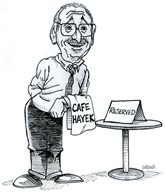While Alexander Hamilton wanted to promote manufacturing with subsidies, which Congress opposed, he was skeptical of high tariffs. No revenue is collected on goods that aren’t legally imported, and Hamilton feared that tariffs would encourage domestic inefficiency. The rising demand for revenue to fund public works and a political effort to protect U.S. producers led to the “Tariff of Abominations” in 1828, which imposed an all-time high average tariff rate of 57.3%. In the following elections tariff supporters suffered devastating electoral defeats as Andrew Jackson and the Democrats were swept into power. From 1830-60 average tariff rates fell by 70%, and industrial production soared at an average annual rate of 6.2%. By 1860 average U.S. tariffs were among the lowest in the world.
In 1842 Congress adopted and Whig President John Tyler signed the so-called “Black Tariff,” the only significant effort to raise tariffs from 1830-60. But less than three months after the enactment of this tariff, the Whigs lost their majority in the House and three seats in the Senate. In the 1844 elections they lost the Senate majority and the presidency. The tariff was repealed.
…..
DBx: The very first U.S. tariff that can fairly be labeled ‘protectionist,’ rather than ‘revenue tariff,’ is the Tariff of 1816. Imposition of that tariff, too, was followed by large electoral losses for the incumbent party, although some historians, including Gordon Wood, blame this loss – perhaps correctly – on public anger over a Congressional pay raise. (See page 720 of Gordon Wood’s marvelous 2009 volume, Empire of Liberty: A History of the Early Republic, 1789-1815.)



